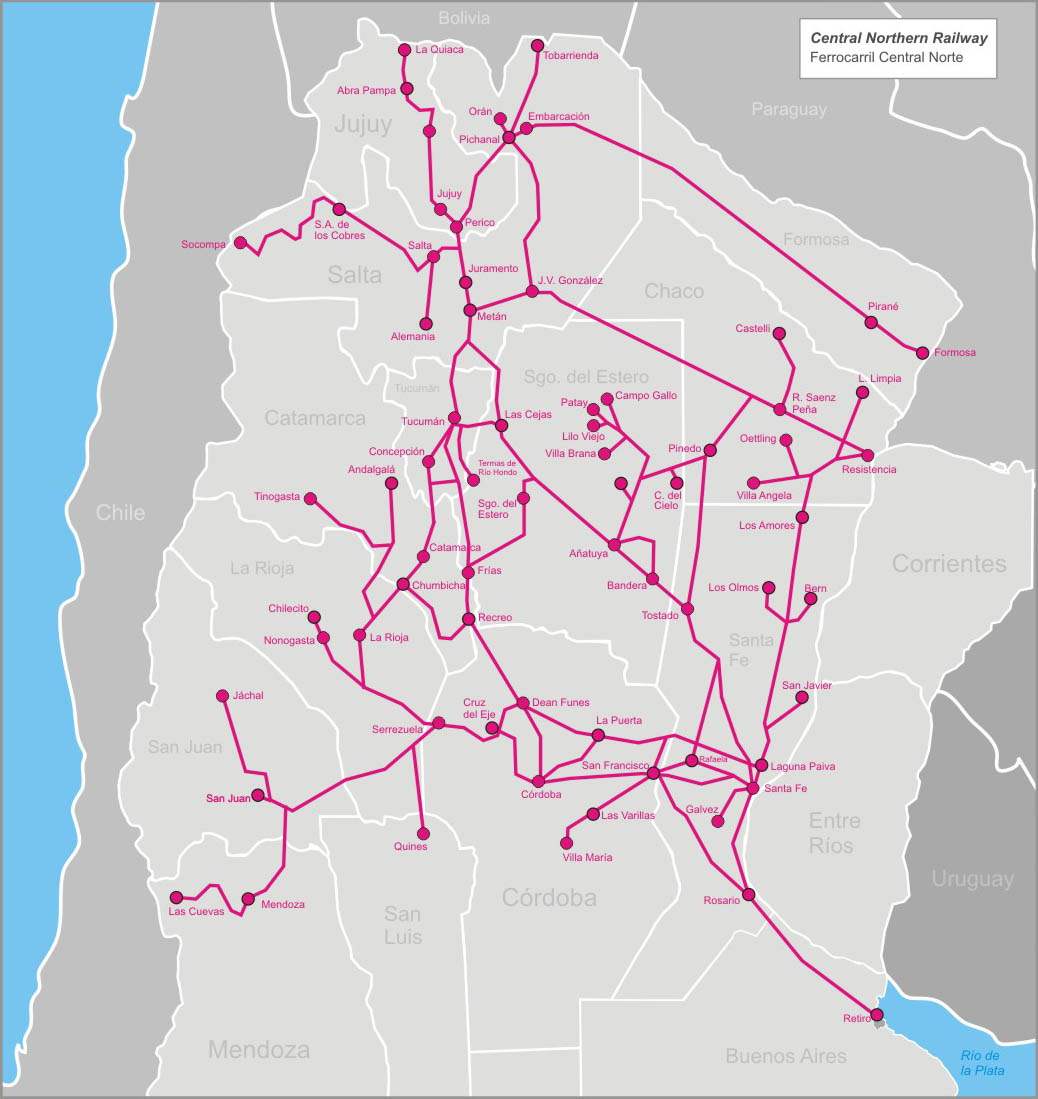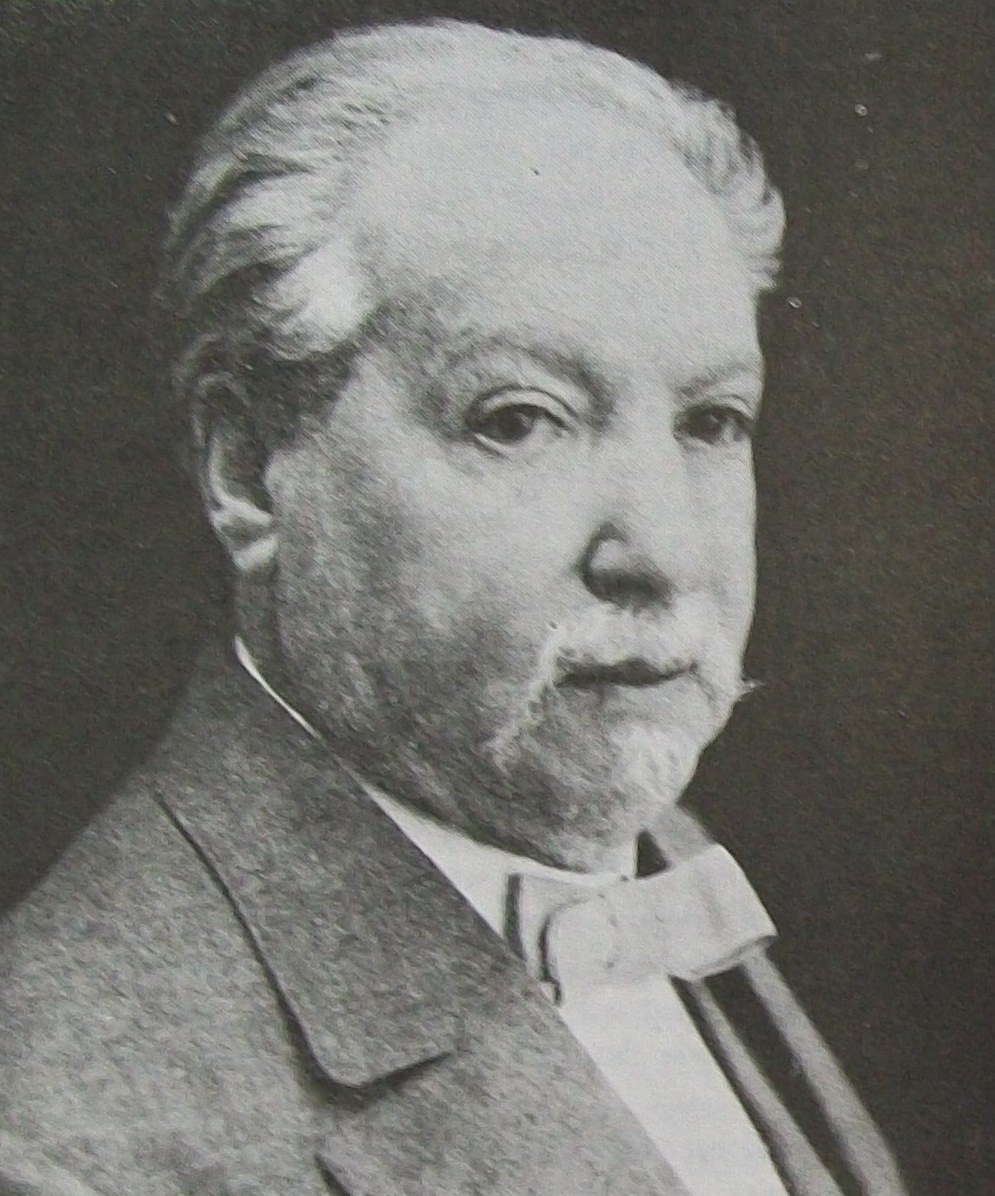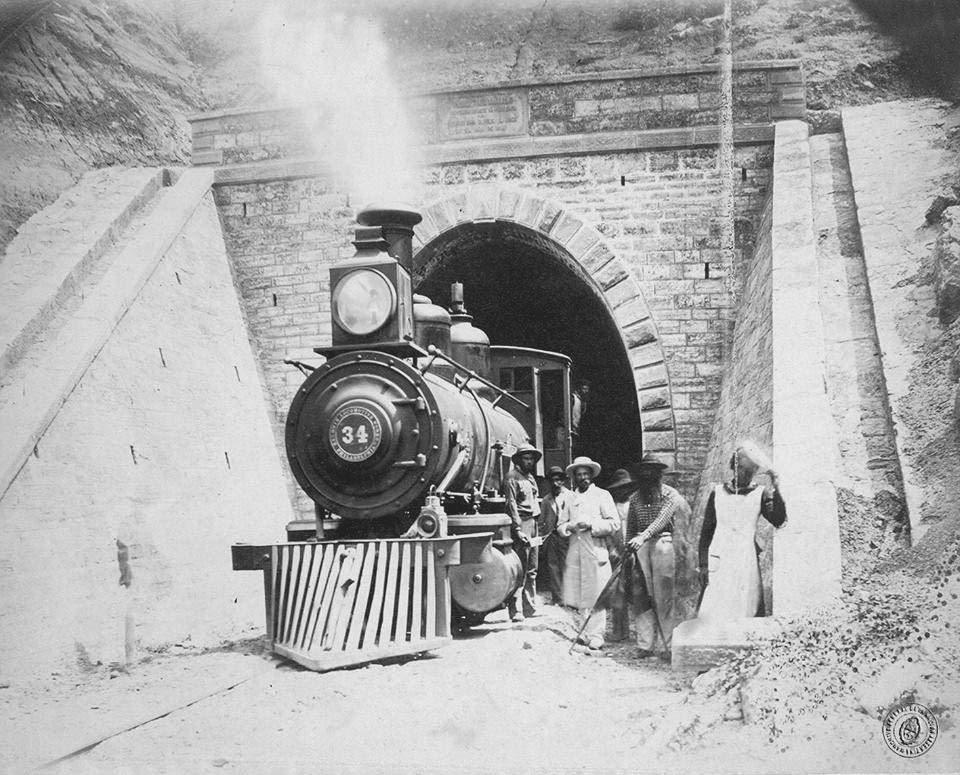|
Argentine State Railway
Argentine State Railway (in Spanish: Ferrocarriles del Estado) was a State-owned railway company of Argentina, established by Law N° 6.757 in October 1909, when José Figueroa Alcorta was the President of Argentina. The company built and operated railway lines in Argentina. History By 1905 the State-owned railway network was 3,490 km length, with the Ferrocarril Central Norte (FCN) being the longest with 1,385 km and the Ferrocarril Argentino del Norte (FAN) with 563 km. Five years later, FCN was 2,135 km long and FAN 1,355 km. In 1925, the Argentine State Railway ranked 2nd among the most important companies in the country, operating a railway network of 6,617 km. By 1936 the railway network had been extended to 9,690 km. Most of the railway lines built by the Argentine state were metre gauge because of financial reasons. In 1937 the State company began to acquire some existing companies with the purpose of competing against British railw ... [...More Info...] [...Related Items...] OR: [Wikipedia] [Google] [Baidu] |
Ganz Works
The Ganz Works or Ganz ( or , ''Ganz companies'', formerly ''Ganz and Partner Iron Mill and Machine Factory'') was a group of companies operating between 1845 and 1949 in Budapest, Hungary. It was named after Ábrahám Ganz, the founder and the manager of the company. It is probably best known for the manufacture of tramcars, but was also a pioneer in the application of Three-phase AC railway electrification, three-phase alternating current to electric railways. Ganz also made ships (''Ganz Danubius''), bridge steel structures (''Ganz Acélszerkezet'') and high-voltage equipment (''Ganz Transelektro''). In the early 20th century the company experienced its heyday, it became the third largest industrial enterprise in Kingdom of Hungary after the ''Manfréd Weiss Steel and Metal Works'' and the ''MÁVAG'' company. Since 1989, various parts of ''Ganz'' have been taken over by other companies. History Before 1919, the company built ocean liners, dreadnought type battleships and su ... [...More Info...] [...Related Items...] OR: [Wikipedia] [Google] [Baidu] |
Juan Domingo Perón
''Juan'' is a given name, the Spanish and Manx versions of ''John''. It is very common in Spain and in other Spanish-speaking communities around the world and in the Philippines, and also (pronounced differently) in the Isle of Man. In Spanish, the diminutive form (equivalent to ''Johnny'') is , with feminine form (comparable to ''Jane'', ''Joan'', or ''Joanna'') , and feminine diminutive (equivalent to ''Janet'', ''Janey'', ''Joanie'', etc.). Chinese terms * ( or 娟, 隽) 'beautiful, graceful' is a common given name for Chinese women. * () The Chinese character 卷, which in Mandarin is almost homophonic with the characters for the female name, is a division of a traditional Chinese manuscript or book and can be translated as 'fascicle', 'scroll', 'chapter', or 'volume'. Notable people * Juan (footballer, born 1979), Brazilian footballer * Juan (footballer, born 1982), Brazilian footballer * Juan (footballer, born March 2002), Brazilian footballer * Juan (footballer ... [...More Info...] [...Related Items...] OR: [Wikipedia] [Google] [Baidu] |
Salta Province
Salta () is a province of Argentina, located in the northwest of the country. Neighboring provinces are from the east clockwise Formosa, Chaco, Santiago del Estero, Tucumán and Catamarca. It also surrounds Jujuy. To the north it borders Bolivia and Paraguay and to the west lies Chile. History Before the Spanish conquest, numerous native peoples (now called Diaguitas and Calchaquíes) lived in the valleys of what is now Salta Province; they formed many different tribes, the Quilmes and Humahuacas among them, which all shared the Cacán language. The Atacamas lived in the Puna, and the Wichís (Matacos), in the Chaco region. The first conquistador to venture into the area was Diego de Almagro in 1535; he was followed by Diego de Rojas. Hernando de Lerma founded San Felipe de Lerma in 1582, following orders of the viceroy Francisco de Toledo, Count of Oropesa; the name of the city was soon changed to "San Felipe de Salta". By 1650, the city had around five hundred inhabitan ... [...More Info...] [...Related Items...] OR: [Wikipedia] [Google] [Baidu] |
Santiago Del Estero Province
Santiago del Estero (), also known simply as Santiago, is a province in the north of Argentina. Neighboring provinces, clockwise from the north, are Salta, Chaco, Santa Fe, Córdoba, Catamarca and Tucumán. History The indigenous inhabitants of these lands were the Juríes-Tonocotés, Sanavirones and other tribes. Santiago del Estero is still home to about 100,000 speakers of the local variety of Quechua, making this the southernmost outpost of the language of the Incas. When the language reached the area, and how, remains unclear—it may even have arrived only with the native troops that accompanied the first Spanish expeditions. Diego de Rojas first reached this land in 1542. Francisco de Aguirre founded the city of Santiago del Estero in 1553 as the northernmost city founded by Spanish conquistadores coming from the Pacific Ocean. Santiago then passed under different governments, from the intendency of Tucumán to the ''Audiencia de Charcas'', then again to Tucumá ... [...More Info...] [...Related Items...] OR: [Wikipedia] [Google] [Baidu] |
Chaco Province
Chaco (; Wichi: ''To-kós-wet''), officially the Province of Chaco ( es, provincia del Chaco ), is one of the 23 provinces in Argentina. Its capital and largest city, is Resistencia. It is located in the north-east of the country. It is bordered by Salta and Santiago del Estero to the west, Formosa to the north, Corrientes to the east, and Santa Fe to the south. It also has an international border with the Paraguayan Department of Ñeembucú. With an area of , and a population of 1,055,259 as of 2010, it is the twelfth most extensive, and the ninth most populated, of the twenty-three Argentine provinces. In 2010, Chaco became the second province in Argentina to adopt more than one official language. These languages are the Kom, Moqoit and Wichí languages, spoken by the Toba, Mocovi and Wichí peoples respectively. Chaco has historically been among Argentina's poorest regions, and currently ranks last both by per capita GDP and on the Human Development Index. Etymology ... [...More Info...] [...Related Items...] OR: [Wikipedia] [Google] [Baidu] |
Formosa Province
Formosa Province () is a Provinces of Argentina, province in northeastern Argentina, part of the Gran Chaco Region. Formosa's northeast end touches Asunción, Paraguay, and the province borders the provinces of Chaco Province, Chaco and Salta Province, Salta to its south and west, respectively. The capital is Formosa, Argentina, Formosa. Source of the provincial name The name of the city (and the province) comes from the archaic Spanish language, Spanish word ''fermosa'' (currently ''hermosa'') meaning "beautiful". The name ''Vuelta Fermosa'' or ''Vuelta la Formosa'' was used by Spanish sailors in the 16th century to describe the area where the Paraguay River makes a turn, right in front of the actual city. These sailors were searching for the legendary Sierra del Plata. History Native inhabitants of these lands include the Pilagás, Wichis and Toba people, Tobas, whose languages are still spoken in the province. Sebastian Cabot (explorer), Sebastian Cabot and Diego García ... [...More Info...] [...Related Items...] OR: [Wikipedia] [Google] [Baidu] |
Tucumán Province
Tucumán () is the most densely populated, and the second-smallest by land area, of the provinces of Argentina. Located in the northwest of the country, the province has the capital of San Miguel de Tucumán, often shortened to Tucumán. Neighboring provinces are, clockwise from the north: Salta, Santiago del Estero and Catamarca. It is nicknamed El Jardín de la República (''The Garden of the Republic''), as it is a highly productive agricultural area. Etymology The word ''Tucumán'' probably originated from the Quechua languages. It may represent a deformation of the term ''Yucumán'', which denotes the "place of origin of several rivers". It can also be a deformation of the word ''Tucma'', which means "the end of things". Before Spanish colonization, the region lay in the outer limits of the Inca empire. History Before the Spanish colonization, this land was inhabited by the Diaguitas and Tonocotes. In 1533, Diego de Almagro explored the Argentine Northwest, incl ... [...More Info...] [...Related Items...] OR: [Wikipedia] [Google] [Baidu] |
Córdoba Province (Argentina)
Córdoba Province may refer to: * Córdoba Province, Argentina * Córdoba Province (Colombia) * Province of Córdoba (Spain) Córdoba (), also called Cordova in English, is one of the 50 provinces of Spain, in the north-central part of the autonomous community of Andalusia. It is bordered by the Andalusian provinces of Málaga, Seville, Jaén, and Granada, the Extre ... {{DEFAULTSORT:Cordoba Province Province name disambiguation pages ... [...More Info...] [...Related Items...] OR: [Wikipedia] [Google] [Baidu] |
Catamarca Province
Catamarca () is a province of Argentina, located in the northwest of the country. The province had a population of 334,568 as per the , and covers an area of 102,602 km2. Its literacy rate is 95.5%. Neighbouring provinces are (clockwise, from the north): Salta, Tucumán, Santiago del Estero, Córdoba, and La Rioja. To the west it borders the country of Chile. The capital is San Fernando del Valle de Catamarca, usually shortened to Catamarca. Other important cities include Andalgalá, Tinogasta, and Belén. Geography Most of Catamarca's territory of 102,602 square kilometers (2.7% of the country total), is covered by mountains (80%), which can be grouped into four clearly differentiated systems: the Pampean sierras, in the east and center; the Narváez-Cerro Negro-Famatina system, in the west; the cordilleran-Catamarca area of transition, in the western extreme; the Puna, an elevated portion, in the northwest. Located in an arid and semi-arid climate zone, the scarce w ... [...More Info...] [...Related Items...] OR: [Wikipedia] [Google] [Baidu] |
La Rioja Province, Argentina
La Rioja () is a province of Argentina located in the west of the country. The landscape of the province consist of a series of arid to semi-arid mountain ranges and agricultural valleys in between. It is in one of these valleys that the capital of the province, the city of la La Rioja, lies. Neighboring provinces are from the north clockwise Catamarca, Córdoba, San Luis and San Juan. The dinosaur '' Riojasaurus'' is named after the province. History Petroglyphs created by early indigenous peoples at the Talampaya National Park are dated around 10,000 years BC. Succeeding cultures of indigenous peoples developed here. The Diaguita, Capayan and the Olongasta peoples inhabited the territory of present-day La Rioja Province at the time of encounter with the Spanish colonists in the 16th century. Juan Ramírez de Velazco founded ''Todos Los Santos de la Nueva Rioja'' in 1591 under the government of Tucumán of the Viceroyalty of Peru. In 1630 the Calchaquí people revolted ... [...More Info...] [...Related Items...] OR: [Wikipedia] [Google] [Baidu] |
Central Northern Railway
The Central Northern Railway (Spanish: ''Ferrocarril Central Norte'', FCCN) was the first ( metre gauge) railway built by the Argentine State Railway. Its aim was to extend the existing British-owned Central Argentine broad gauge) railway from Córdoba to Tucuman and metre gauge was chosen for economic reasons. History Origins A Law promulgated in October 1868 destinated money collected from foreign trade and import taxes to the construction of a railway line between the Provinces of Córdoba and Jujuy. The construction and subsequent operation of the line was entrusted to "Compañía Telfner", who began to work on the line in 1873, reaching the city of Recreo ( Catamarca) on 1 May 1875, San Antonio, Jujuy in July that same year and finally reaching San Miguel de Tucumán on 30 October 1876, being formally inaugurated by then President of Argentina, Nicolás Avellaneda. On 28 December 1876 the national government took over the running of the line and appointed Rafaé ... [...More Info...] [...Related Items...] OR: [Wikipedia] [Google] [Baidu] |
Patagonian Railw Arg
Patagonia () refers to a geographical region that encompasses the southern end of South America, governed by Argentina and Chile. The region comprises the southern section of the Andes Mountains with lakes, fjords, temperate rainforests, and glaciers in the west and deserts, tablelands and steppes to the east. Patagonia is bounded by the Pacific Ocean on the west, the Atlantic Ocean to the east, and many bodies of water that connect them, such as the Strait of Magellan, the Beagle Channel, and the Drake Passage to the south. The Colorado and Barrancas rivers, which run from the Andes to the Atlantic, are commonly considered the northern limit of Argentine Patagonia. The archipelago of Tierra del Fuego is sometimes included as part of Patagonia. Most geographers and historians locate the northern limit of Chilean Patagonia at Huincul Fault, in Araucanía Region.Manuel Enrique Schilling; Richard WalterCarlson; AndrésTassara; Rommulo Vieira Conceição; Gustavo Walter Berto ... [...More Info...] [...Related Items...] OR: [Wikipedia] [Google] [Baidu] |







